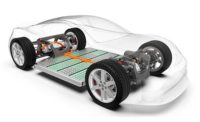New System Monitors EV Batteries

Electrochemical impedance spectroscopy technology can be used to improve the stability and performance of high-capacity batteries in electric vehicles.
Illustration courtesy Korea Advanced Institute of Science & Technology
Engineers at the Korea Advanced Institute of Science & Technology (KAIST) have developed a way to precisely determine the health of batteries by only using small amounts of electrical current. Their electrochemical impedance spectroscopy (EIS) technology may improve the stability and performance of high-capacity batteries in electric vehicles.
In addition to assessing the state of charge and state of health of batteries, the tool can be used to identify thermal characteristics, chemical or physical changes, predict battery life and determine the causes of failures.
Traditional EIS equipment is expensive and complex, making it difficult to install, operate and maintain. And, due to sensitivity and precision limitations, applying current disturbances of several amperes to a battery can cause significant electrical stress, increasing the risk of battery failure or fire.
The KAIST system can precisely measure battery impedance with low current disturbances, minimizing thermal effects and safety issues during the measurement process. It minimizes bulky and costly components, making it easy to integrate into EVs.
The system was proven effective in identifying the electrochemical properties of batteries under various operating conditions, including different temperatures and state of charge levels.
“This system can be easily integrated into the battery management system of electric vehicles and has demonstrated high measurement accuracy, while significantly reducing the cost and complexity compared to traditional high-current EIS methods,” says Kyeongha Kwon, Ph.D., an electrical engineering professor at KAIST. “It can contribute to battery diagnosis and performance improvements not only for electric vehicles, but also for energy storage systems.”
Looking for a reprint of this article?
From high-res PDFs to custom plaques, order your copy today!






